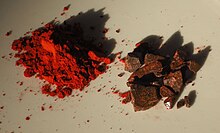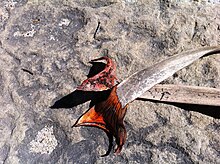Dragon's blood

Dragon's blood is a bright red resin which is obtained from different species of a number of distinct plant genera: Calamus spp. (previously Daemonorops) also including Calamus rotang, Croton, Dracaena and Pterocarpus. The red resin has been in continuous use since ancient times as varnish, medicine, incense, pigment, and dye.
Name and source

A great degree of confusion existed for the ancients in regard to the source and identity of dragon's blood. Some medieval encyclopedias claimed its source as the literal blood of elephants and dragons who had perished in mortal combat.[1][2] The resin of Dracaena species, "true" dragon's blood, and the very poisonous mineral cinnabar (mercury sulfide)[3] were often confused by the ancient Romans. In ancient China, little or no distinction was made among the types of dragon's blood from the different species. Both Dracaena and Calamus resins are still often marketed today as dragon's blood, with little or no distinction being made between the plant sources; however, the resin obtained from Calamus has become the most commonly sold type in modern times, often in the form of large balls of resin. Resins that come from different species and different continents have been given the name “dragon's blood,” but their purity, appearance, and chemical properties are highly varied.[4]
Voyagers to the
Dragon's blood resin is also produced from the
The red latex of the Sangre de Drago (called Sangre de Grado in Peru), from any of seven species of Croton native to Peru, Bolivia, Ecuador and Brazil, has purported wound-healing and antioxidant properties, and has been used for centuries by native people. The species are:[5]
- Croton draconoides Muell. Arg., (wikispecies)
- Croton palanostigma Klotzsch, (wikispecies)
- Croton perpecosus Croiza, (wikispecies)
- Croton rimbachii Croizat, (wikispecies)
- Croton sampatik Muell. Arg., (wikispecies)
- Croton erythrochilus Muell. Arg., (wikispecies)
- Croton lechleri Muell. Arg., (wikispecies)
Visual characteristics
In his study of artists' pigments, the chemist George Field described dragon's blood as “a warm semi-transparent, rather dull, red colour, which is deepened by impure air, and darkened by light.”[6]
History and uses
This section may contain verify the text. (June 2023) ) |
This section needs additional citations for verification. (June 2023) |
The dragon's blood known to the ancient Romans was mostly collected from D. cinnabari, and is mentioned in the 1st century

A notable occurrence of dragon's blood red in art is in Giotto's Pentecost. In this painting, it is believed that the pigment used in the orange-red flames over the Apostles' heads is dragon's blood.[8]
Locals on
Dragon's blood of both Dracaena draco (commonly referred to as the Draconis Palm) and Dracaena cinnabari were used as a source of varnish for 18th century Italian violinmakers. There was also an 18th-century recipe for toothpaste that contained dragon's blood.
Dragon's blood from both Calamus were used for ceremonies in India. Sometimes Dracaena resin, but more often Calamus resin, was used in China as red varnish for wooden furniture. It was also used to colour the surface of writing paper for banners and posters, used especially for weddings and for Chinese New Year.
Dragon's blood incense is also occasionally sold as "red rock opium" to unsuspecting would-be drug buyers. It actually contains no opiates, and has only slight psychoactive effects, if any at all.[10]
Thaspine from the Dragon's Blood of the species Croton lechleri has possible use as a cancer drug.[11]
Today, dragon's blood from a South American plant can be bought in health food stores.[12]
According to Pliny the Elder, dragon's blood was used by artists in antiquity. Painters continued to use it in the creation of flesh tones during the 17th century. By the 19th century, publications on artists' materials indicate that it was most useful as a varnish, not as pigment for painting. In 1835, George Field stated that dragon's blood is “unsatisfactory for painting.” However, the pigment was used to prepare the color known as "Chinese orange."[13]
Today, dragon's blood has a variety of uses. Outside of it being a pigment in paintings and colors, it is still used as a varnish for violins, in photoengraving, as a medicine, as an incense resin, and as a body oil.[citation needed]
Safety
A study on oral toxicity of the DC resin methanol extract taken from the perennial tree Dracaena cinnabari was performed on female Sprague Dawley rats in February 2018. Acute and sub-acute oral toxicity tests found that the extract could be tolerated up to 2,000 mg/kg body weight.[14]
List of botanical sources

- Calamus rotang L.
- Calamus draco Willd. (synonyms include Daemonorops draco, D. rubra)
- Calamus didymophyllus Becc. Ridl. (synonyms include Daemonorops motleyi, D. didymophylla)
- Müll. Arg.
- Cham.
- Croton lechleri Müll. Arg.
- Croton erythrochilus Müll. Arg.
- Klotzsch
- Croizat
- Croton rimbachii Croizat
- Croton sampatik Müll. Arg.
- Baill.
- Kunth
- Balf.f.
- Dracaena cochinchinensis hort. ex Baker
- Dracaena draco (L.) L.
- Jacq.
See also
- Crofelemer, South American tree (Croton lechleri), unrelated to Dracaena and rattan palm (the generus Calamus)
Footnotes
- ^ De Hamel, Christopher (1992). Scribes and Illuminators. Medieval Craftsmen series. Toronto: University of Toronto Press. p. 62.
- OCLC 936144129.
- ^ "Safety data for mercuric sulphide". ox.ac.uk. Archived from the original on 2009-09-22. Retrieved 2009-02-15.
- PMID 18060708.
- ISBN 978-9972910302.
- ISBN 978-1110185221.
- ISBN 0-691-04060-5.
- OCLC 642214264.
- PMID 6658717.
- ^ "Erowid Opiates Vault : "Red Rock Opium" Myth #1". Erowid.org. Retrieved 2011-01-28.
- PMID 19798419.
- ISBN 9780226470528.
- ISBN 0-7506-57499.
- PMID 29402248.|
Further reading
- ISBN 978-0-88192-574-6.
- Schafer, E. H. (1963). The Golden Peaches of Samarkand: A study of T'ang Exotics. University of California Press. p. 211. ISBN 978-0520054622.
- Schoff, Wilfred H. (1995) [1912]. The Periplus of the Erythraean Sea. South Asia Books. ISBN 81-215-0699-9.
